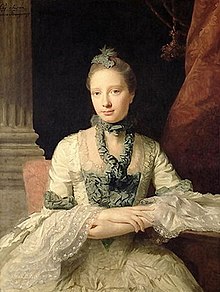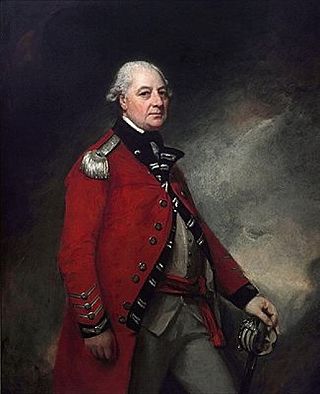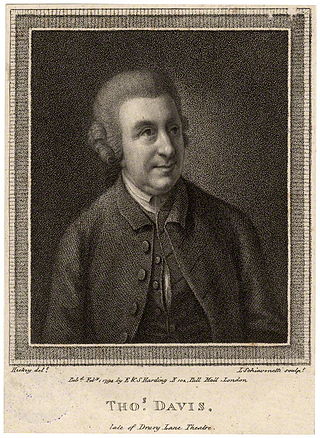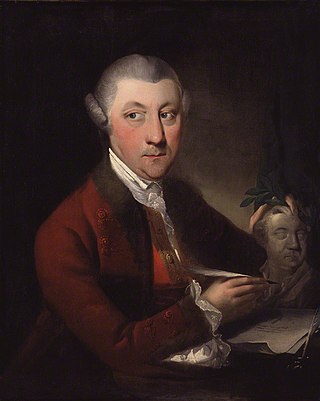
William O'Brien (c.1740-1815) was an Irish actor and playwright.

William O'Brien (c.1740-1815) was an Irish actor and playwright.
William O'Brien was probably born in County Clare in about 1740 to a family which claimed a distant connection to the Viscounts Clare. His father was a fencing master in Dublin [1] David Garrick brought O'Brien over to London from Dublin in 1758 to join his actor's company at Drury Lane. O'Brien was successful in a number of roles, particularly Shakespeare and contemporary comedies. [2] He eloped with Lady Susannah "Susan" Fox-Strangways, eldest daughter of Stephen Fox, the first Earl of Ilchester, whom he had met when they both performed in amateur theatricals at Holland House. [3] Their marriage, which took place on 7 April 1764 at St. Paul's Church, Covent Gardens, was disapproved of by Lady Susan's family.
Following the marriage, O'Brien retired from the stage. The couple were forced for a time to travel to North America, because of the social scandal caused by their elopement. They set sail for New York in September 1764. Although neither husband nor wife were happy there, they travelled widely, sailing up the Hudson, travelling west to Niagara Falls, and then north to Quebec where O'Brien briefly served as a barrack master. In 1768, he was gazetted Secretary and Provost-Master-General of the Bermudas.
On their return to England in 1770, the O'Briens lived for a time in London where O'Brien entered a brief but unsuccessful career as a playwright. He was the author of two plays, Cross-Purposes (1772) and The Duel (1773). The diarist James Boswell described O'Brien as "a lively little fellow, but priggish" and "quite the fine man about town". [4]

The O'Briens later moved to live at a Strangways family property, Stinsford House, in Dorset. The couple had no children. O'Brien served as Receiver-General of Dorset until shortly before his death in 1815. O'Brien and Lady Susan were buried together at the church of St Michael's at Stinsford. [5]
Nicholas Irons portrayed O'Brien in the 1999 TV miniseries Aristocrats .

Michael Arne was an English composer, harpsichordist, organist, singer, and actor. He was the son of the composer Thomas Arne and the soprano Cecilia Young, a member of the famous Young family of musicians of the seventeenth and eighteenth centuries. Like his father, Arne worked primarily as a composer of stage music and vocal art song, contributing little to other genres of music. He wrote several songs for London's pleasure gardens, the most famous of which is Lass with the Delicate Air (1762). A moderately prolific composer, Arne wrote nine operas and collaborated on at least 15 others. His most successful opera, Cymon (1767), enjoyed several revivals during his lifetime and into the early nineteenth century.

Richard Brinsley Butler Sheridan was an Anglo-Irish playwright, writer and Whig politician who sat in the British House of Commons from 1780 to 1812, representing the constituencies of Stafford, Westminster and Ilchester. The owner of the Theatre Royal, Drury Lane in London, he wrote several prominent plays such as The Rivals (1775), The Duenna (1775), The School for Scandal (1777) and A Trip to Scarborough (1777), along with serving as Treasurer of the Navy from 1806 to 1807. After dying in 1816, Sheridan was buried at Poets' Corner in Westminster Abbey, and his plays remain a central part of the Western canon and are regularly performed around the world.

Lady Christian Henrietta Caroline Acland was a British noblewoman and diarist. She accompanied her husband to British North America and became celebrated for her personal courage. She is commemorated on one of the bronze reliefs on second floor of the Saratoga Monument in the State of New York.

Baron Inchiquin is one of the older titles in the Peerage of Ireland. It was one of two titles created on 1 July 1543 for Murrough O'Brien, Prince of Thomond, who claimed descent from Brian Boru, a High King of Ireland. The grant of the English titles was conditional upon the abandonment of any Irish titles, the adoption of English customs and laws, pledging of allegiance to the Crown, apostasy from the Catholic Church, and conversion to the Church of Ireland. Murrough was made both Earl of Thomond in the Peerage of Ireland, with remainder to his nephew Donough O'Brien and Baron Inchiquin, with remainder to his male heirs. Following the death of his cousin, Conor Myles John O' Brien in June 2023, Conor John Anthony O' Brien is currently the 19th Baron Inchiquin

Bunratty Castle is a large 15th-century tower house in County Clare, Ireland. It is located in the centre of Bunratty village, by the N18 road between Limerick and Ennis, near Shannon Town and its airport. The castle and the adjoining folk park are run by Shannon Heritage as tourist attractions.

Field Marshal George Townshend, 1st Marquess Townshend, PC, known as The Viscount Townshend from 1764 to 1787, was a British soldier and politician. After serving at the Battle of Dettingen during the War of the Austrian Succession and the Battle of Culloden during the Jacobite Rising, Townshend took command of the British forces for the closing stages of the Battle of the Plains of Abraham during the Seven Years' War. He went on to be Lord Lieutenant of Ireland or Viceroy where he introduced measures aimed at increasing the size of Irish regiments, reducing corruption in Ireland and improving the Irish economy. In cooperation with Prime Minister North in London, he solidified governmental control over Ireland. He also served as Master-General of the Ordnance, first in the North Ministry and then in the Fox–North Coalition.

Stinsford is a village and civil parish in southwest Dorset, England, about 1 mile (1.6 km) east of Dorchester. The parish includes the settlements of Higher and Lower Bockhampton. The name Stinsford may derive from stynt, Old English for a limited area of pasture. In the 2011 United Kingdom census, the parish had a population of 334.

John Montagu, 5th Earl of Sandwich, PC, styled Viscount Hinchingbrooke until 1792, was a British peer and Tory politician.

Thomas Davies was a Scottish bookseller and author. He studied at the University of Edinburgh and was for some years on the stage; but having been ridiculed by Churchill in The Rosciad he gave up acting and opened a bookshop in Covent Garden. It was here that in 1763 he introduced Boswell to Dr. Johnson, who was his close friend and to whom he dedicated his edition of the works of Massinger. He wrote a successful Life of Garrick (1780), which passed through four editions, and Dramatic Miscellanies.

Stephen Fox-Strangways, 1st Earl of Ilchester PC was a British peer and Member of Parliament.

Henry Thomas Fox-Strangways, 2nd Earl of Ilchester, known as Lord Stavordale from 1756 to 1776, was a British peer and Member of Parliament.

The Livingston family of New York is a prominent family that migrated from Scotland to the Dutch Republic, and then to the Province of New York in the 17th century. Descended from the 4th Lord Livingston, its members included signers of the United States Declaration of Independence and the United States Constitution. Several members were Lords of Livingston Manor and Clermont Manor, located along the Hudson River in 18th-century eastern New York.

William Robert FitzGerald, 2nd Duke of Leinster, KP, PC (Ire) was an Irish liberal politician and landowner. He was born in London.

William Kenrick was an English novelist, playwright, translator and satirist, who spent much of his career libelling and lampooning his fellow writers.

Elizabeth Hartley (1750?–1824) was one of the most celebrated actresses on the London stage in the 18th century. She was also notorious for the role she played in society scandals including "The Vauxhall Affray".

Thomas Hull (1728–1808) was an English actor and dramatist.

Holland House, originally known as Cope Castle, was an early Jacobean country house in Kensington, London, situated in a country estate that is now Holland Park. It was built in 1605 by the diplomat Sir Walter Cope. The building later passed by marriage to Henry Rich, 1st Baron Kensington, 1st Earl of Holland, and by descent through the Rich family, then became the property of the Fox family, during which time it became a noted gathering-place for Whigs in the 19th century. The house was largely destroyed by German firebombing during the Blitz in 1940 and today only the east wing and some ruins of the ground floor and south facade remain, along with various outbuildings and formal gardens. In 1949 the ruin was designated a grade I listed building and it is now owned by the Royal Borough of Kensington and Chelsea.

Elizabeth Fox, Countess of Ilchester (c.1723–1792), née Elizabeth Horner, was the wife of Stephen Fox-Strangways, 1st Earl of Ilchester.

Henry Woodward was an English actor, among the most famous in his day for comedy roles.